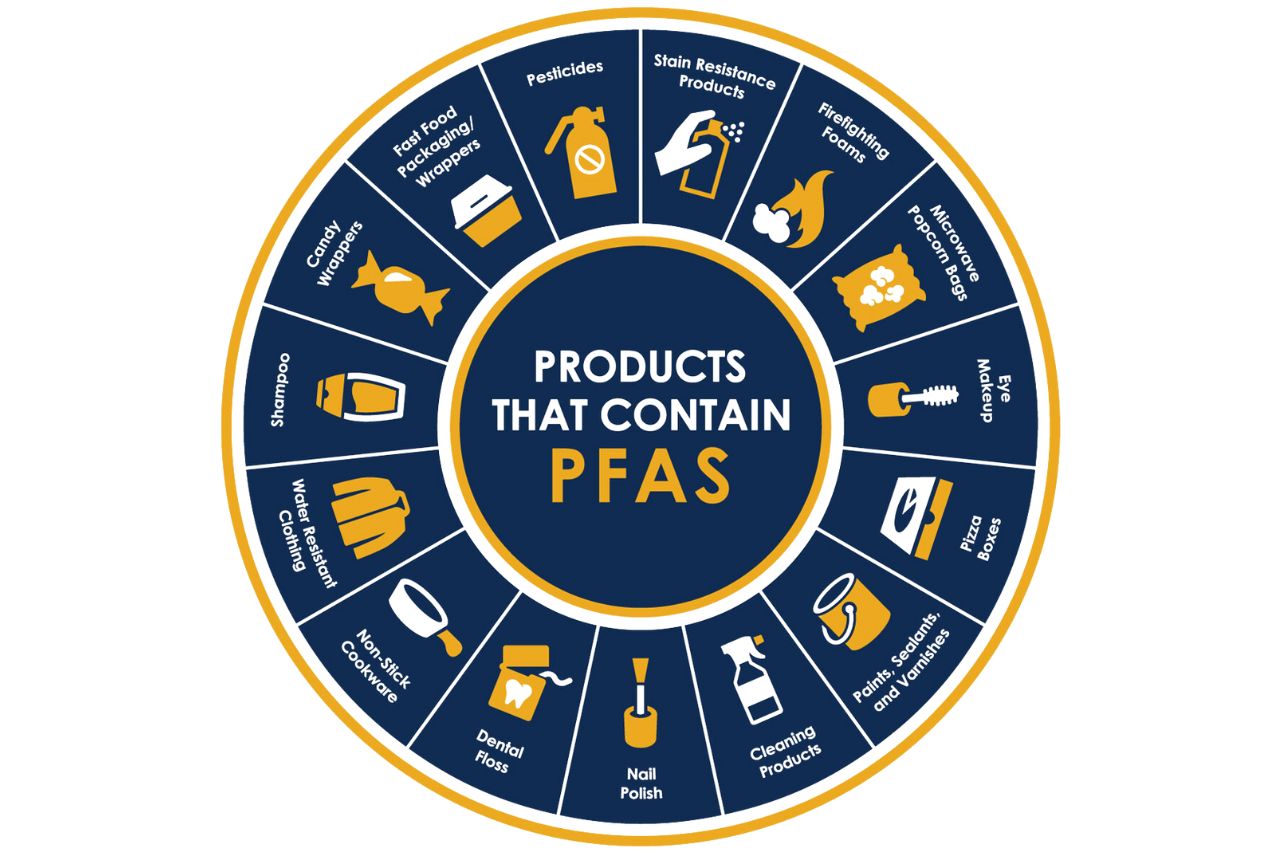PFAS 101: Your Top Questions About PFAS Answered
Have you heard of PFAS chemicals? They’re dangerous substances found in everyday items, causing harm to our health and the environment. PFAS, or per- and polyfluoroalkyl substances, are man-made chemicals used in non-stick cookware, food packaging, and firefighting foam. The problem is that they persist over time, accumulating in our bodies and the environment, resulting in serious health issues like cancer and reproductive problems. Despite the risks, many companies still use PFAS, endangering our health and the environment. Let’s raise awareness and demand that companies remove these harmful chemicals from their products.
What are PFAS Chemicals?
PFAS chemicals are a group of man-made chemicals that have been used in a variety of consumer products for decades. The chemicals are known for their ability to repel water and oil, which makes them ideal for use in non-stick cookware, food packaging, and firefighting foam. They are also used in a variety of other products, including carpets, clothing, and cosmetics.
The problem with PFAS chemicals is that they don’t break down over time. This means that they can accumulate in our bodies and the environment, leading to serious health issues. PFAS chemicals are known to cause liver damage, cancer, and reproductive problems. They are also linked to developmental issues in children and a weakened immune system.
Despite these dangers, many companies continue to use PFAS chemicals in their products. This is because PFAS chemicals are cheap and effective, making them an attractive option for manufacturers. However, the long-term health consequences of PFAS chemicals are too great to ignore.
The Dangers of PFAS Chemicals
The dangers of PFAS chemicals are well-documented. These chemicals have been linked to a variety of health issues, including liver damage, cancer, and reproductive problems. They are also linked to developmental issues in children and a weakened immune system. The long-term health consequences of PFAS chemicals are still being studied, but the evidence so far is clear: these chemicals are harmful to our health.
One of the biggest concerns with PFAS chemicals is their ability to accumulate in our bodies. This means that even small amounts of exposure can have a significant impact on our health over time. PFAS chemicals are also persistent in the environment, meaning that they don’t break down over time. This can lead to long-term contamination of our air, water, and soil.
Another concern with PFAS chemicals is their impact on wildlife. Studies have shown that these chemicals can have a negative impact on fish, birds, and other animals. This can lead to a disruption of ecosystems and a decline in biodiversity.
Where Can PFAS Chemicals be Found?

PFAS chemicals can be found in a variety of consumer products, including non-stick cookware, food packaging, and firefighting foam. They are also used in carpets, clothing, and cosmetics. PFAS chemicals are widespread in the environment and have been found in soil, water, and air samples around the world.
One of the most concerning sources of PFAS contamination is drinking water. PFAS chemicals can enter our water supply through industrial discharges, wastewater treatment plants, landfills, and other sources. Once in our water supply, these chemicals can accumulate in our bodies over time, leading to serious health issues.
It’s important to note that not all products that contain PFAS chemicals are labeled as such. This means that it can be difficult to know which products contain these harmful chemicals. To reduce your exposure to PFAS chemicals, it’s important to read product labels carefully and choose products that are free of PFAS chemicals whenever possible.
The Impact of PFAS Chemicals on the Environment
PFAS chemicals have a significant impact on the environment. These chemicals are persistent in the environment, meaning that they don’t break down over time. This can lead to long-term contamination of our air, water, and soil.
One of the most concerning environmental impacts of PFAS chemicals is their impact on wildlife. Studies have shown that these chemicals can have a negative impact on fish, birds, and other animals. This can lead to a disruption of ecosystems and a decline in biodiversity.
PFAS chemicals can also contaminate our water supply, which can have a significant impact on human health. Once in our water supply, these chemicals can accumulate in our bodies over time, leading to serious health issues like cancer, liver damage, and reproductive problems.
PFAS Chemicals in Drinking Water
PFAS chemicals are a significant concern when it comes to drinking water. These chemicals can enter our water supply through industrial discharges, wastewater treatment plants, landfills, and other sources. Once in our water supply, these chemicals can accumulate in our bodies over time, leading to serious health issues.
The EPA has set a health advisory level of 70 parts per trillion (ppt) for PFAS chemicals in drinking water. However, this level is not enforceable and many communities have found levels of PFAS chemicals in their drinking water that exceed this advisory level.
To reduce your exposure to PFAS chemicals in drinking water, it’s important to be aware of potential sources of contamination in your area. You can contact your local water utility to learn more about the quality of your drinking water and any potential sources of contamination.
PFAS 101: Your Top 5 Frequently Asked Questions Answered
Below are answer to the top 5 frequently asked questions about PFAS:

How are people exposed to PFAS?
PFAS can be found in a wide range of products and materials, including non-stick cookware, food packaging, stain-resistant carpeting, and firefighting foam. As a result, exposure to these chemicals can occur through a variety of routes, including ingestion, inhalation, and dermal contact.
One of the most common ways people are exposed to PFAS is through contaminated drinking water. PFAS chemicals are highly resistant to degradation, which means they can persist in the environment and accumulate in water sources over time. This is particularly concerning for communities located near military bases, airports, and other industrial sites where PFAS-containing firefighting foam has been historically used.
Another potential source of PFAS exposure is through the use of certain consumer products, such as non-stick cookware and stain-resistant fabrics. When these products are heated or washed, they can release PFAS chemicals into the air or water, which can be inhaled or ingested by humans and animals.
To reduce your risk of exposure to PFAS, it’s important to be aware of the products and materials that contain these chemicals and to take steps to reduce your use of them whenever possible. This may include using alternative cookware and cleaning products, filtering your drinking water, and avoiding products treated with stain-resistant coatings.
What filter removes pfas from drinking water?
If you’re concerned about PFAS contamination in your drinking water, one of the most effective ways to reduce your exposure is by using a water filter that is specifically designed to remove these chemicals.
One type of filter that is particularly effective at removing PFAS is known as activated carbon. This type of filter works by adsorbing (not absorbing) the chemicals onto its surface, effectively removing them from the water. However, not all activated carbon filters are created equal, and some may be more effective than others at removing PFAS.
Another type of filter that has been shown to be effective at removing PFAS is reverse osmosis. This type of filter uses a semi-permeable membrane to remove impurities from the water, including PFAS. However, reverse osmosis filters can be more expensive and require more maintenance than activated carbon filters.
No matter which type of filter you choose, it’s important to select one that is certified to remove PFAS. Look for filters that have been tested and certified by organizations such as NSF International or the Water Quality Association.
How do you test tap water for PFAS?
If you’re concerned about PFAS contamination in your tap water, there are several ways to test for the presence of these chemicals. One option is to contact your local water utility or health department and request a water test. Many communities now offer free or low-cost testing for PFAS and other contaminants.
Another option is to purchase a home water testing kit that is specifically designed to detect PFAS. These kits are available online or at many home improvement stores and can provide you with a quick and easy way to test your water for these chemicals.
When choosing a home testing kit, it’s important to select one that is certified to detect PFAS. Look for kits that have been tested and certified by organizations such as NSF International or the Environmental Protection Agency.
What products will replace PFAS?
As concerns about PFAS continue to grow, many companies are looking for alternatives to these chemicals in their products. Some of the alternatives that have been proposed include:
- Natural materials: Some companies are exploring the use of natural materials, such as plant-based fibers and coatings, as alternatives to PFAS-containing materials.
- Fluorine-free alternatives: Other companies are developing fluorine-free alternatives to PFAS, such as coatings and textiles that use different types of chemicals to achieve water and stain resistance.
- Biodegradable materials: Some researchers are exploring the use of biodegradable materials, such as chitosan and cellulose, as alternatives to PFAS-containing materials.
While there is no one-size-fits-all solution to replacing PFAS, many companies are making progress in finding safer alternatives to these chemicals. By supporting companies that are actively working to reduce or eliminate PFAS from their products, consumers can help to drive the market towards safer, more sustainable materials.
What regulations and guidelines are in place for PFAS?

In response to growing concerns about PFAS contamination, several regulatory agencies have developed guidelines and regulations to address these chemicals. Some of the key regulations and guidelines include:
- The Environmental Protection Agency (EPA) has established a health advisory level of 70 parts per trillion (ppt) for PFAS in drinking water. This means that if the level of PFAS in your drinking water exceeds 70 ppt, it may pose a health risk and you should take steps to reduce your exposure.
- The Department of Defense (DOD) has established a goal of phasing out the use of PFAS-containing firefighting foam by 2024. The DOD is also conducting extensive testing of water sources near military bases to determine the extent of PFAS contamination.
- Several states have established their own regulations and guidelines for PFAS. For example, Michigan has set a maximum contaminant level of 9 ppt for PFAS in drinking water, while New Jersey has established a strict limit of 14 ppt for PFAS in surface water.
By staying up-to-date on the latest regulations and guidelines for PFAS, consumers can help to protect themselves and their communities from the potential health risks associated with these chemicals.
Final Thoughts
PFAS chemicals are a hidden threat lurking in our everyday products. These chemicals are persistent in the environment and can accumulate in our bodies over time, leading to serious health issues like cancer, liver damage, and reproductive problems. Despite the dangers, many companies continue to use PFAS chemicals in their products, putting our health and the environment at risk.
It’s time we raise awareness about the dangers of PFAS chemicals and demand that companies take action to eliminate these harmful chemicals from their products. We can also take steps to reduce our own exposure to PFAS chemicals by reading product labels carefully and choosing products that are free of these harmful chemicals whenever possible.
By working together, we can reduce our exposure to PFAS chemicals and protect our health and the environment for future generations.

